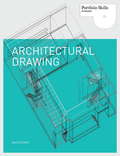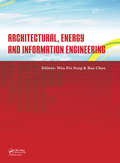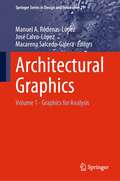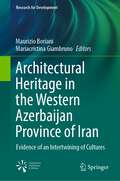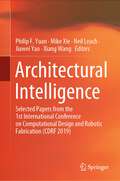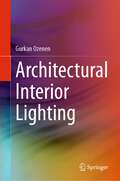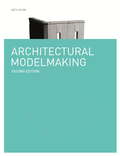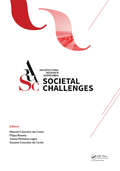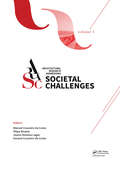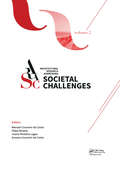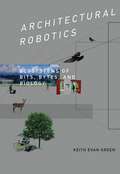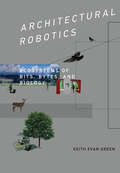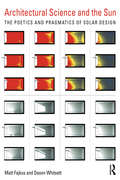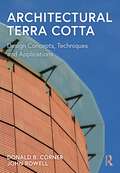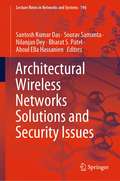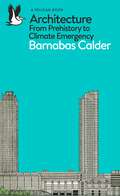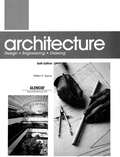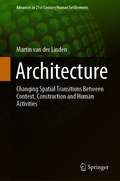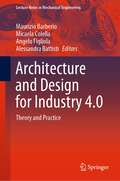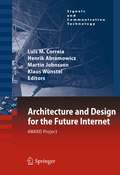- Table View
- List View
Architectural Drawing (Portfolio Skills)
by David DernieThis book focuses on the exciting possibilities for representing the built environment with all the techniques – both ancient and modern – that are now available. It teaches students the following skills: how to draw using a range of media, the basic rules of making effective spatial images, how to read a drawing, and how to express ideas through appropriate media and forms of communication. Following a brief introduction, the book is divided into three sections: Media, Types and Places. Each section is illustrated with exemplary drawings and accompanying commentaries. Step-by-step sequences and practical tips will further help students to make the most of their newly acquired skills. This book is an indispensable practical and inspirational resource in architectural schools and practices alike.
Architectural Drawing, 2nd edition
by David DernieThis book focuses on the exciting possibilities for representing the built environment with techniques ranging from pencil sketching to computers. It teaches students the following skills: how to draw using a range of media, the basic rules of making effective spatial images, and how to express ideas through appropriate media and forms of communication. Following a revised and expanded introduction, the book is divided into three sections: Media, Types and Places. Each section is illustrated with exemplary drawings and accompanying commentaries. Step-by-step sequences and practical tips will further help students to make the most of their newly acquired skills. The second edition includes more on a variety of techniques, particularly digital, and new artworks from practising architects, making it an indispensable practical and inspirational resource.
Architectural Drawing Second Edition
by David DernieThis book focuses on the exciting possibilities for representing the built environment with techniques ranging from pencil sketching to computers. It teaches students the following skills: how to draw using a range of media, the basic rules of making effective spatial images, and how to express ideas through appropriate media and forms of communication. Following a revised and expanded introduction, the book is divided into three sections: Media, Types and Places. Each section is illustrated with exemplary drawings and accompanying commentaries. Step-by-step sequences and practical tips will further help students to make the most of their newly acquired skills. The second edition includes more on a variety of techniques, particularly digital, and new artworks from practising architects, making it an indispensable practical and inspirational resource.
Architectural, Energy and Information Engineering: Proceedings of the 2015 International Conference on Architectural, Energy and Information Engineering (AEIE 2015), Xiamen, China, May 19-20, 2015
by Wen-Pei Sung Ran ChenThis proceedings volume brings together selected peer-reviewed papers presented at the 2015 International Conference on Architectural, Energy and Information Engineering (AEIE 2015), held July 15-16, 2015 in Hong Kong, China. The proceedings are divided into two parts, Architectural, Energy and Environmental Engineering and Information Enginee
Architectural Graphics: Volume 3 - Graphics for Education and Thought (Springer Series in Design and Innovation #23)
by José Calvo-López Manuel A. Ródenas-López Macarena Salcedo-GaleraThis book reports on several advances in architectural graphics, with a special emphasis on education, training and research. It gathers a selection of contributions to the 19th International Conference on Graphic Design in Architecture, EGA 2022, held on June 2–4, 2022, in Cartagena, Spain, with the motto: "Beyond drawings. The use of architectural graphics".
Architectural Graphics: Volume 1 - Graphics for Analysis (Springer Series in Design and Innovation #21)
by Manuel A. Ródenas-López José Calvo-López Macarena Salcedo-GaleraThis book reports on several advances in architectural graphics, with a special emphasis on education, training, and research. It gathers a selection of contributions to the 19th International Conference on Graphic Design in Architecture, EGA 2022, held on June 2–4, 2022, in Cartagena, Spain, with the motto: "Beyond drawings. The use of architectural graphics".
Architectural Graphics: Volume 2 - Graphics for Knowledge and Production (Springer Series in Design and Innovation #22)
by Manuel A. Ródenas-López José Calvo-López Macarena Salcedo-GaleraThis book reports on several advances in architectural graphics, with a special emphasis on education, training and research. It gathers a selection of contributions to the 19th International Conference on Graphic Design in Architecture, EGA 2022, held on June 2–4, 2022, in Cartagena, Spain, with the motto: "Beyond drawings. The use of architectural graphics".
Architectural Heritage in the Western Azerbaijan Province of Iran: Evidence of an Intertwining of Cultures (Research for Development)
by Maurizio Boriani Mariacristina GiambrunoThis book represents a reflection on the policies of preservation that were established and interventions for restoration that occurred in Iran before and in the years after the Khomeinist Revolution, as well as being an analysis of the impact that Italian restoration culture has had in the country. Research concerning the state of conservation and the ongoing restoration of the Armenian churches in the Khoy and Salmas areas is included, along with precise documentation of the observation of the two cities, their architecture and the context of their landscape. The problems of architectural restoration in present-day Iran and the compatible use of buildings no longer intended for worship are addressed. The book is bolstered by first-hand documentation obtained through inspections and interviews with Iranian specialists during three missions carried out between 2016 and 2018 and a large anthology of period texts that have only recently been made available for the first time for study in electronic form, including travel reports written by Westerners describing Persia between the 15th and 19th centuries.
Architectural Intelligence: Selected Papers from the 1st International Conference on Computational Design and Robotic Fabrication (CDRF 2019)
by Philip F. Yuan Mike Xie Neil Leach Jiawei Yao Xiang WangThis book presents selected papers from The 1st International Conference on Computational Design and Robotic Fabrication (CDRF 2019). Focusing on novel architecture theories, tools, methods, and procedures for digital design and construction in architecture, it promotes dialogs between architecture, engineer, computer science, robotics, and other relevant disciplines to establish a new way of production in the building industry in the digital age. The contents make valuable contributions to academic researchers and engineers in the industry. At the same time, it offers readers new ideas for the application of digital technology.
Architectural Interior Lighting
by Gurkan OzenenArchitectural Interior Lighting is an essential guide to creating well-lit, visually appealing interior spaces. The book begins with an overview of light and color theory, lighting fundamentals, and design principles. It then covers artificial, natural, decorative, and professional lighting in interior design, as well as standards and regulations, controls and systems, sustainable lighting, energy efficiency, light pollution reduction, and the use of environmentally friendly materials. With a focus on practical applications and real-world examples, this book provides readers with the tools and knowledge necessary to achieve their design goals while considering the latest trends and techniques in the field. A valuable resource for professionals and students in architecture and lighting design, it will also appeal to anyone interested in creating visually stunning and functional interior spaces.
Architectural Modelmaking Second Edition
by Nick DunnThe physical model is an important communication tool for architects. Although the proliferation of CAD programs has enabled the creation of increasingly complex computer models and virtual environments, there is also a growing need to address the three-dimensional qualities of architecture that may be lost when using such media. This book focuses on the inspiring possibilities for modelling the built environment with all the different media and techniques available. In describing the use of different models in different contexts, the book provides a practical guide to how and why models are used, and what they are used for. This second edition includes more detailed step-by-step exercises, expanded discussion of materials and techniques, updated coverage of digital techniques and new case studies.
Architectural Research Addressing Societal Challenges: Proceedings of the EAAE ARCC 10th International Conference (EAAE ARCC 2016), 15-18 June 2016, Lisbon, Portugal
by Manuel Jorge Rodrigues Couceiro da Costa Filipa Roseta Susana Couceiro da Costa Joana Pestana LagesThe escalating interdependecy of nations drives global geopolitics to shift ever more quickly. Societies seem unable to control any change that affects their cities, whether positively or negatively. Challenges are global, but solutions need to be implemented locally. How can architectural research contribute to the future of our changing society? How has it contributed in the past? The theme of the 10th EAAE/ARCC International Conference, “Architectural Research Addressing Societal Challenges”, was set to address these questions. This book, Architectural Research Addressing Societal Challenges, includes reviewed papers presented in June 2016, at the 10th EAAE/ARCC International Conference, which was held at the facilities of the Faculty of Architecture of the University of Lisbon. The papers have been further divided into the following five sub-themes: a Changing Society; In Transit – Global Migration; Renaturalization of the City; Emerging Fields of Architectural Practice; and Research on Architectural Education. The EAAE/ARCC International Conference, held under the aegis of the EAAE and of the ARCC, is a conference organized every other year, in collaboration with one of the member schools/ universities of those associations, alternatively in North America or in Europe.
Architectural Research Addressing Societal Challenges Volume 1: Proceedings of the EAAE ARCC 10th International Conference (EAAE ARCC 2016), 15-18 June 2016, Lisbon, Portugal
by Manuel Jorge Rodrigues Couceiro da Costa Filipa Roseta Susana Couceiro da Costa Joana Pestana LagesThe EAAE/ARCC International Conference, held under the aegis of the EAAE (European Association for Architectural Education) and of the ARCC (Architectural Research Centers Consortium), is a conference organized every other year, in collaboration with one of the member schools / universities of those associations, alternatively in North America or in Europe. The EAAE/ARCC Conferences began at the North Carolina State University College of Design, Raleigh with a conference on Research in Design Education (1998); followed by conferences in Paris (2000), Montreal (2002), Dublin (2004), Philadelphia (2006), Copenhagen (2008), Washington (2010), Milan (2012) and Honolulu (2014). The conference discussions focus on research experiences in the field of architecture and architectural education, providing a critical forum for the dissemination and engagement of current ideas from around the world.
Architectural Research Addressing Societal Challenges Volume 2: Proceedings of the EAAE ARCC 10th International Conference (EAAE ARCC 2016), 15-18 June 2016, Lisbon, Portugal
by Manuel Jorge Rodrigues Couceiro da Costa Filipa Roseta Susana Couceiro da Costa Joana Pestana LagesThe EAAE/ARCC International Conference, held under the aegis of the EAAE (European Association for Architectural Education) and of the ARCC (Architectural Research Centers Consortium), is a conference organized every other year, in collaboration with one of the member schools / universities of those associations, alternatively in North America or in Europe. The EAAE/ARCC Conferences began at the North Carolina State University College of Design, Raleigh with a conference on Research in Design Education (1998); followed by conferences in Paris (2000), Montreal (2002), Dublin (2004), Philadelphia (2006), Copenhagen (2008), Washington (2010), Milan (2012) and Honolulu (2014). The conference discussions focus on research experiences in the field of architecture and architectural education, providing a critical forum for the dissemination and engagement of current ideas from around the world.
Architectural Robotics: Ecosystems of Bits, Bytes, and Biology
by Keith Evan GreenThe relationship of humans to computers can no longer be represented as one person in a chair and one computer on a desk. Today computing finds its way into our pockets, our cars, our appliances; it is ubiquitous -- an inescapable part of our everyday lives. Computing is even expanding beyond our devices; sensors, microcontrollers, and actuators are increasingly embedded into the built environment. In Architectural Robotics, Keith Evan Green looks toward the next frontier in computing: interactive, partly intelligent, meticulously designed physical environments. Green examines how these "architectural robotic" systems will support and augment us at work, school, and home, as we roam, interconnect, and age.Green tells the stories of three projects from his research lab that exemplify the reconfigurable, distributed, and transfigurable environments of architectural robotics. The Animated Work Environment is a robotic work environment of shape-shifting physical space that responds dynamically to the working life of the people within it; home+ is a suite of networked, distributed "robotic furnishings" integrated into existing domestic and healthcare environments; and LIT ROOM offers a simulated environment in which the physical space of a room merges with the imaginary space of a book, becoming "a portal to elsewhere."How far beyond workstations, furniture, and rooms can the environments of architectural robotics stretch? Green imagines scaled-up neighborhoods, villages, and metropolises composed of physical bits, digital bytes, living things, and their hybrids. Not global but local, architectural robotics grounds computing in a capacious cyber-physical home.
Architectural Robotics: Ecosystems of Bits, Bytes, and Biology
by Keith Evan GreenHow a built environment that is robotic and interactive becomes an apt home to our restless, dynamic, and increasingly digital society.The relationship of humans to computers can no longer be represented as one person in a chair and one computer on a desk. Today computing finds its way into our pockets, our cars, our appliances; it is ubiquitous—an inescapable part of our everyday lives. Computing is even expanding beyond our devices; sensors, microcontrollers, and actuators are increasingly embedded into the built environment. In Architectural Robotics, Keith Evan Green looks toward the next frontier in computing: interactive, partly intelligent, meticulously designed physical environments. Green examines how these “architectural robotic” systems will support and augment us at work, school, and home, as we roam, interconnect, and age.Green tells the stories of three projects from his research lab that exemplify the reconfigurable, distributed, and transfigurable environments of architectural robotics. The Animated Work Environment is a robotic work environment of shape-shifting physical space that responds dynamically to the working life of the people within it; home+ is a suite of networked, distributed “robotic furnishings” integrated into existing domestic and healthcare environments; and LIT ROOM offers a simulated environment in which the physical space of a room merges with the imaginary space of a book, becoming “a portal to elsewhere.”How far beyond workstations, furniture, and rooms can the environments of architectural robotics stretch? Green imagines scaled-up neighborhoods, villages, and metropolises composed of physical bits, digital bytes, living things, and their hybrids. Not global but local, architectural robotics grounds computing in a capacious cyber-physical home.
Architectural Science and the Sun: The Poetics and Pragmatics of Solar Design
by Dason Whitsett Matt FajkusArchitectural Science and the Sun synthesizes physics, climate, program, and perception to provide a foundation in the principles of architectural science related to the sun: solar geometry, solar analysis and design techniques, passive design principles, and daylighting. Part analytical handbook, part inspiration source for schematic design, the content comprises a critical component of effective sustainable design. Beyond the purely technical aspects of these topics, Architectural Science and the Sun begins with the premise that great architecture goes beyond energy performance and the visual-aesthetic to engage all of the senses. Given that the stimuli to which our senses respond are physical phenomena such as light, heat, and sound, the designer must manipulate these parameters through the craft of building form and technology to create the desired qualitative experience. This book is designed to help the reader develop that skill.
Architectural Technology: Research and Practice
by Stephen Emmitt… it gives me great pleasure to support the first ever publication to specifically address the area of research, and in particular its relationship with practice, in the discipline of architectural technology…not only ground breaking because it is the first book of its kind, but also because it provides at long last one of the accepted foundations needed to underpin the emerging academic discipline, namely a recognised research base. CIAT, in supporting this publication, is aware of the need for books such as this to sustain the process of research informed practice, as an aid for both students and those practising within the discipline of architectural technology. Norman Wienand MCIAT, Vice President Education, Chartered Institute of Architectural Technologists Architectural technology is the realisation of architecture through the application of building science, forming the constructive link between the abstract and the physical. Architectural Technology: research and practice demonstrates the importance of research in architectural technology and aims to stimulate further research and debate by enlightening, informing and challenging readers. Chapter authors address the interplay between research and practice in the field of architectural technology, examining the influence of political, economic, social, environmental and technological issues. The focus throughout is on creating sustainable buildings that are constructed economically and function effectively and efficiently within their service life cycle. The book’s mix of chapters and case studies bring together a number of different themes and provides invaluable insights into the world of research from the perspective of those working within the architectural technology field - practitioners, academics and students. The underlying message is that architectural technology is not just a profession; it is a way of thinking and a way of acting. This is highlighted by contributions from architects and architectural technologists passionate about architectural technology as a field of knowledge. Contributions range from the theoretical and polemic to the pragmatic and applied, further helping to demonstrate the richness of the field. About the Editor Stephen Emmitt is Professor of Architectural Technology at Loughborough University UK and Visiting Professor of Innovation Sciences at Halmstad University, Sweden and a member of CIAT’s Research Group.
Architectural Terra Cotta: Design Concepts, Techniques and Applications
by Donald B. Corner John RowellArchitectural Terra Cotta examines the evolution of terra cotta and prepares architects and builders to make new, creative uses of the timeless material. Terra cotta is among the oldest of manufactured building products, yet it has once again become a material of choice in contemporary façade design. From the walls of Babylon to high performance rainscreens, terra cotta claddings have repeatedly proven to be technically superior and aesthetically triumphant. Understanding the evolution of terra cotta prepares architects to add new, creative chapters to a rich history. This book describes the key attributes that recommend the use of terra cotta and explain its continuing success. The core of the book traces the many ways that terra cotta can be formed, finished and applied to buildings. These techniques demonstrate the full potential of the material, showing how its unique capabilities have been developed over time. A comprehensive inventory of recent examples, project case studies and architectural details, this book provide a basis for understanding the nature of the material and the opportunities it offers in new work. With over 150 color images, this volume provides a concise resource for all those considering terra cotta as a façade system: architects, façade engineers, cladding subcontractors, materials suppliers, developers and prospective clients. With inspiring examples of expressive possibility, this invaluable book will find a home with students and professionals alike interested in making rich, colorful and durable buildings.
Architectural Wireless Networks Solutions and Security Issues (Lecture Notes in Networks and Systems #196)
by Santosh Kumar Das Sourav Samanta Nilanjan Dey Bharat S. Patel Aboul Ella HassanienThis book presents architectural solutions of wireless network and its variations. It basically deals with modeling, analysis, design and enhancement of different architectural parts of wireless network. The main aim of this book is to enhance the applications of wireless network by reducing and controlling its architectural issues. The book discusses efficiency and robustness of wireless network as a platform for communication and data transmission and also discusses some challenges and security issues such as limited hardware resources, unreliable communication, dynamic topology of some wireless networks, vulnerability and unsecure environment. This book is edited for users, academicians and researchers of wireless network. Broadly, topics include modeling of security enhancements, optimization model for network lifetime, modeling of aggregation systems and analyzing of troubleshooting techniques.
Architecture: From Prehistory to Climate Emergency (Pelican Books)
by Barnabas CalderA groundbreaking history of architecture told through the relationship between buildings and energyThe story of architecture is the story of humanity. The buildings we live in, from the humblest pre-historic huts to today's skyscrapers, reveal our priorities and ambitions, our family structures and power structures. And to an extent that hasn't been explored until now, architecture has been shaped in every era by our access to energy, from fire to farming to fossil fuels.In this ground-breaking history of world architecture, Barnabas Calder takes us on a dazzling tour of some of the most astonishing buildings of the past fifteen thousand years, from Uruk, via Ancient Rome and Victorian Liverpool, to China's booming megacities. He reveals how every building - from the Parthenon to the Great Mosque of Damascus to a typical Georgian house - was influenced by the energy available to its architects, and why this matters.Today architecture consumes so much energy that 40% of the world's greenhouse gas emissions come from the construction and running of buildings. If we are to avoid catastrophic climate change then now, more than ever, we need beautiful but also intelligent buildings, and to retrofit - not demolish - those that remain. Both a celebration of human ingenuity and a passionate call for greater sustainability, this is a history of architecture for our times.
Architecture: Design, Engineering, Drawing
by William Perkins SpenceDesigned especially for college design courses and drafting classes, the text provides an overview of the planning and design of residential and commercial buildings
Architecture: Changing Spatial Transitions Between Context, Construction and Human Activities (Advances in 21st Century Human Settlements)
by Martin van der LindenThe question of what architecture is answered in this book with one sentence: Architecture is space created for human activities. The basic need to find food and water places these activities within a larger spatial field. Humans have learned and found ways to adjust to the various contextual difficulties that they faced as they roamed the earth. Thus rather than adapting, humans have always tried to change the context to their activities. Humanity has looked at the context not merely as a limitation, but rather as a spatial situation filled with opportunities that allows, through intellectual interaction, to change these limitations. Thus humanity has created within the world their own contextual bubble that firmly stands against the larger context it is set in. The key notion of the book is that architecture is space carved out of and against the context and that this process is deterministic.
Architecture and Design for Industry 4.0: Theory and Practice (Lecture Notes in Mechanical Engineering)
by Maurizio Barberio Micaela Colella Angelo Figliola Alessandra BattistiThis book collects contributions of forefront research and practices related to the use of the enabling technologies of Industry 4.0 in the architecture and design fields and their impact on the UN's Sustainable Developments goals. The book is structured into three sections (research, practice, and technologies), with the goal of creating a new framework useful for widespread awareness necessary to initiate technology transfer processes for the benefit of the public sector, universities, research centers, and innovative companies, and a new professional figure capable of controlling the entire process is essential. Thus, the book chapters arouse a series of relevant topics such as computational and parametric design, performance-based architecture, data-driven design strategies, parametric environmental design and analysis, computational and parametric structural design and analysis, AI and machine learning, BIM and interoperability, VR and AR, digital and robotic fabrication, additive manufacturing and 3D printing, R&D and entrepreneurship, circular architecture, and didactics. In the post-digital era, where the essence of design lies in the control and information of the process that holistically involves all the aspects mentioned above, rather than in formal research, it is necessary to understand technologies and analyze the advantages that they can bring in terms of environmental sustainability and product innovation.
Architecture and Design for the Future Internet: 4WARD Project (Signals and Communication Technology)
by Luis M. Correia Klaus Wünstel Henrik Abramowicz Martin JohnssonArchitecture and Design for the Future Internet addresses the Networks of the Future and the Future Internet, focusing on networks aspects, offering both technical and non-technical perspectives. It presents the main findings of 4WARD (Architecture and Design for the Future Internet), a European Integrated Project within Framework Programme 7, which addressed this area from an innovative approach. Today's network architectures are stifling innovation, restricting it mostly to the application level, while the need for structural change is increasingly evident. The absence of adequate facilities to design, optimise and interoperate new networks currently forces a convergence to an architecture that is suboptimal for many applications and that cannot support innovations within itself, the Internet. 4WARD overcomes this impasse through a set of radical architectural approaches, built on a strong mobile and wireless background. The main topics addressed by the book are: the improved ability to design inter-operable and complementary families of network architectures; the enabled co-existence of multiple networks on common platforms through carrier-grade virtualisation for networking resources; the enhanced utility of networks by making them self-managing; the increased robustness and efficiency of networks by leveraging diversity; and the improved application support by a new information-centric paradigm in place of the old host-centric approach. These solutions embrace the full range of technologies, from fibre backbones to wireless and sensor networks.
